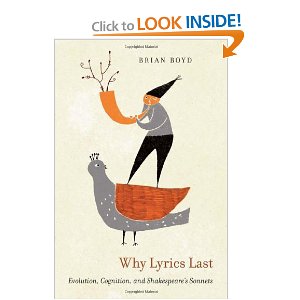Loved this discussion:
 Bryan Boyd Interviewed by Kim Hill
Bryan Boyd Interviewed by Kim Hill
Here is the book:

Kindle
I will read the book. But as I listened I was burning to join in on the discussion. I have since my days studying under Prof. Robert Bigelow in the late 60s at Canterbury had an understanding of “gene pools”. The concept makes sense of how some things might benefit the survival of a species even when individuals do not have more babies.
Brian Boyd touched on this lightly in the interview, I’ll be interested to see if he does this more fully in the book.
The point is this: if lyrical poetry (or anything else) is useful to the group then only a few need to have a gene for it, and even if they individually don’t have more babies, the group as a whole might survive and a neighbouring group who does not have that gene in their pool might not.
I’ve been thinking about this in relationship to the purpose of monogamy. It seems that it has a special place in healing wounds from childhood. But this typically does not happen till after the crucial childbearing years, in the second reflective half of life. I think of the powerful impact even one or two healing couples can have in a group. They can foster relationship education as well. They might influence psychological health, and more robust grandchildren.
PS
Bigelow’s book here: Amazon – The Dawn Warriors





